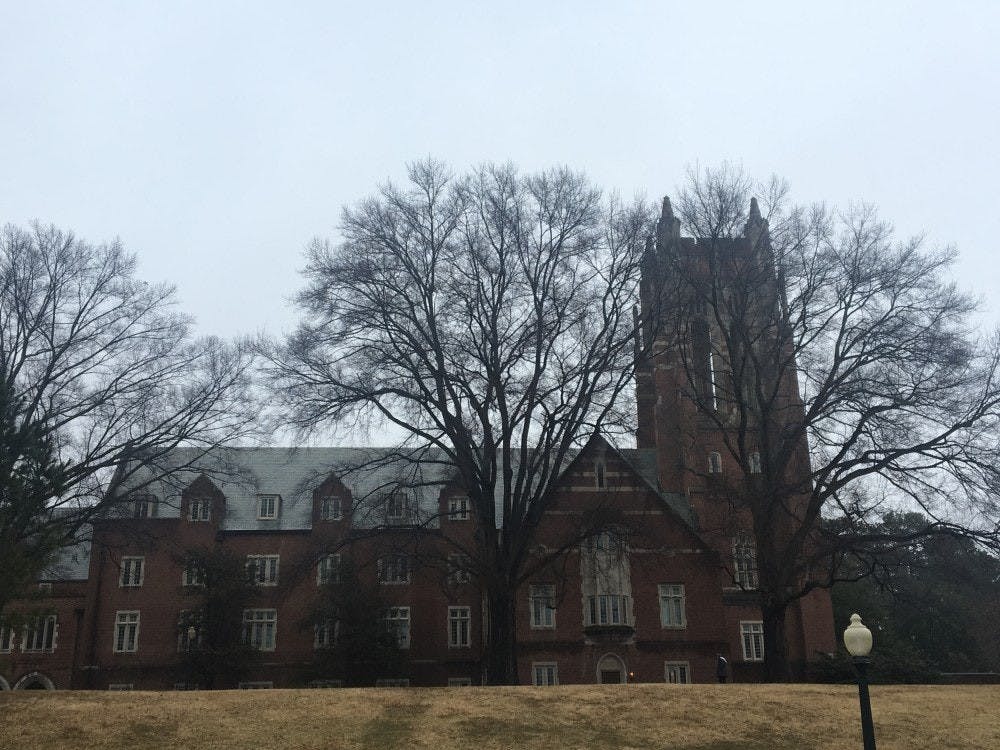The University of Richmond campus may look completely different when you return for your five- or 10-year reunion – and university staff members are already hard at work envisioning what changes will be made.
The Boatwright Memorial Library/Tyler Haynes Commons Envisioning Committee has been holding student focus groups, meeting with architects and forming task forces to brainstorm what changes can be made to improve the center of campus.
The committee was created in the fall of 2017, in the wake of the university’s launch of its Strategic Plan in May 2017, said Steve Bisese, vice president for student development. The plan focuses on improving campus across five pillars, including “academic excellence” and “thriving and inclusive university community.”
“It became apparent that the central area of campus is so vital to those kinds of things,” Bisese, a co-chair of the committee, said.
Bisese said he considered the swath of campus stretching from the library to the Commons to be a central part of UR. Because the Commons hasn’t been renovated since 2007, and because it serves so many purposes, Bisese said he saw the Envisioning Committee as a chance to dig deeper into the area’s “deciding purpose.”
The committee has divided the area in question into three distinct task forces, Bisese said, representing the library, the Commons and the surrounding green space.
Bisese cites the recent changes to the Current, the open area on the first floor of the Commons, as an example of the kind of re-thinking that the committee is working on. The walls that had separated individual TV pods in the area were removed this past year, Bisese said, in an effort to provide the open sort of space that people wanted.
For Bisese, new developments and changes to this area come down to creating places where student life and academics can come together.
“We’re very effective at moving people along very fast,” he explained. “We need to create spaces that allow you to just relax.”
One idea floated out was the idea of extending the Commons out onto Westhampton Lake by 10 feet or so and adding open-air tables and chairs. Committee co-chair Kevin Butterfield also brought up the possibility of installing garage-like doors in the front of the Commons to allow students to pass in and out.
Butterfield, the university librarian, heads the library task force. For Butterfield, future improvements begin with one question:
“How are we using the space we have, and how can we use it more effectively?”
Enjoy what you're reading?
Signup for our newsletter
The library includes three separate “buildings,” Butterfield said. This can present unique challenges: from the main study area of the library, Butterfield pointed out, you can’t get to the Lora Robins Gallery or the School of Arts and Sciences dean’s office.
Although both of these spaces are technically part of the library, they are separate from the collections and study spaces, and cannot be accessed without exiting the building.
The weird layout of the library comes from an older view of buildings, Butterfield explained, when libraries were designed “so you can’t get a book out anywhere but the front door.”
Butterfield wants to aid in improving space use by exploring changes that could make the library more user-friendly.
One of these potential changes could be moving different sections of the library so that “public-facing services,” such as the Technology Learning Center, are more accessible. Butterfield cited the TLC as well as the Center for Teaching, Learning and Technology and the Book Arts Studio as examples of university services that are tucked away on floors that students rarely frequent.
One of Butterfield’s suggestions is to move the TLC to the first floor and move special collections and archives up to a higher floor. He has also considered creating an entrance at the rear of the library, adding video or teleconferencing capabilities to library study rooms, and clustering resources such as the writing center and research librarians together to form “student success centers.”
“What you want to avoid is the library becoming just a really pretty study hall,” Butterfield said.
As for the area in front of the library by the lake, the green space could be extended, Butterfield said, with the possibility of removing certain parking lots and turning the lake into a sort of eco-classroom.
As exciting as the new possibilities are, they’re still just possibilities. The committee’s purpose is to envision what effective future development could look like.
“This is the kind of study where we’re dreaming,” Bisese said. “We have no idea if it’s feasible.”
But the committee members have taken solid steps in their envisioning process. They have formed task forces and focus groups, scheduled interviews with architects, selected a firm and arranged for five architect visits designed to help illuminate the possibilities available to revitalize the area.
Senior Gardner Nash is one of the students who’s been collaborating with committee members on the project.
Nash said he thought some members of the campus community were still lacking a place to “call their own.” The Envisioning Committee represented a chance to change that, he said.
“While on face value we are here to modernize these central landmarks that define the aesthetic of our campus,” Nash said, “the fundamental importance of our work is the ability to shape the spaces that will determine our campus culture and priorities.”
The first architect meeting was in spring 2018. In October 2018, Bisese and Butterfield sent out a survey, asking for feedback on how the spaces could be redesigned to best accommodate the needs of students, faculty and staff.
The process is ongoing, but one thing Bisese sees in the committee’s future is taking the results on a sort of “road show,” presenting ideas to university faculty, staff and students. He compared it to the path of the new wellness center, which was presented on 17 occasions to groups such as Panhellenic Council and Interfraternity Council.
But first, the Envisioning Committee has to finish meeting with the consulting architects. Bisese said the third visit was scheduled for around the end of finals week this December.
The UR students who submitted surveys and served on focus groups likely won’t still be students here by the time the changes come to fruition. Still, the Envisioning Committee serves as reminder of all the possibilities that lie ahead.
“I know that this work will materialize when I am gone,” Nash said, “but I am excited to think about the potential to come back to campus one day and see a space that all students can call their own with pride.”
Contact features writer Molly Brind'Amour at molly.brindamour@richmond.edu.
Support independent student media
You can make a tax-deductible donation by clicking the button below, which takes you to our secure PayPal account. The page is set up to receive contributions in whatever amount you designate. We look forward to using the money we raise to further our mission of providing honest and accurate information to students, faculty, staff, alumni and others in the general public.
Donate Now



